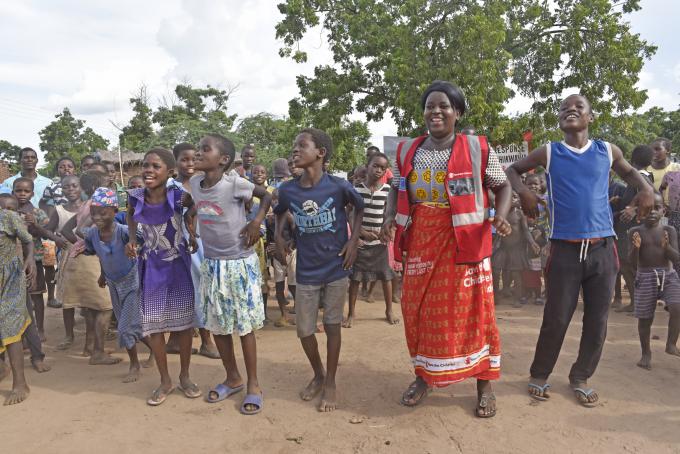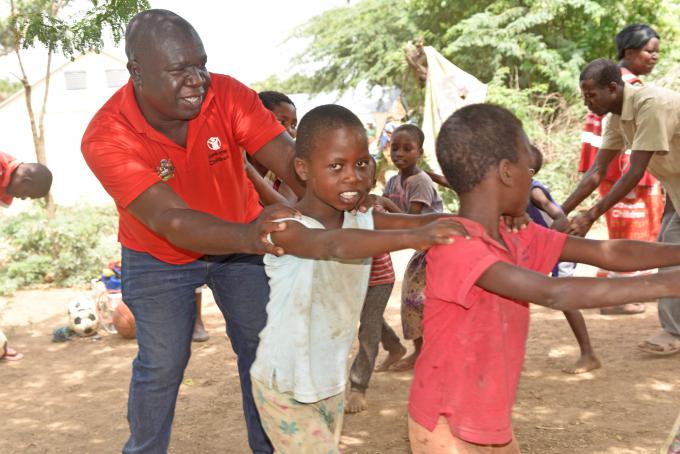Helping Children Cope with Floods Trauma


It is 3 am on the night of 26 January on Chikuse Island on the Shire River in Chikwawa District. Twelve-year-old Joseph* is deep in sleep when he is awoken by loud screams as his parents jolt him and his four siblings from sleep, ordering them to immediately vacate the house.
It has been raining insistently for the past two days but they had been no warning of what was to follow.
As the family exit the house, they wade straight into the raging waters that have now surrounded the houses. Disaster has struck.
As soon as the family exit, the house immediately collapses into a heap, meaning that the family has escaped death by a few seconds. But the waters keep rising rapidly, forcing the family to seek shelter on the only structure that is still standing—a makeshift kitchen that the family uses. But this too gives way under the weight of this family of seven.
Desperate, Joseph’s father ushers the family towards the only other sanctuary in sight, a tree on the grounds of the compound. But as they head there, the father loses grip of one of his five-year-old son, who is immediately swallowed and washed away by the waters. This is the last time the family ever sees him.
The family hangs on to the tree for the entire day until rescue arrives around 4 pm.
“I miss my brother. He was my best friend in the whole family,” explains a visibly distraught Joseph, whose family, alongside the entire community from Chikuse Island, has since relocated to Chikuse Camp in Nchalo.
According to the chairman of the camp Paul Ndamera, Chikuse Camp currently caters for a total population of 5,836 of whom 1,383 are children aged under 15.
At the camp, authorities noticed that Joseph was being reclusive and looked depressed most of the time.
As a means of helping him heal, the youngster has been incorporated into a Children’s Corner programme where young children aged between six and 18 are encouraged to socialize and encourage each other.
Save the Children are implementing a child protection programme in 15 of the 23 camps spread across Chikwawa.
Daisy Chitimbe, the organisation’s humanitarian child protection officer, says Joseph’s case is not unique as most of the children in the camps have had to deal with the trauma of the floods.
“We have two groups, the Child Safe Space Centres for young children aged between three and five and the Children’s Corner that caters for six to 18 year olds,” she says.
For the Child Safe Space Centres, the team uses games and song to help the children to physically, mentally, and psychologically cope with the ordeal of living in the camps.
According to Chitimbe, for the older group, the team employs a healing and education through art (HEART) approach that uses art as a coping mechanism.
“We ask them to draw art on the ground depicting the experience that went through during the floods. From what they draw, you can tell that some of the children are really troubled ad they have serious problems. So, we then take them away from the group therapy and deal with them separately for individual therapy,” she says.
She adds that sometimes, the cases are so serious that they have to refer them to child protection officers for specialist therapy.
The Save the Children intervention is in response to Tropical Storm Ana which affected Malawi, with Chikwawa being the most affected of the districts in the country.
In collaboration with the District Office, Save the Children is implementing protection, education and health interventions. Child protection activities are coordinated by protection cluster members led by the District Social Welfare Office. The initiatives promote child participation, safeguarding and resilience.
“Child protection interventions aim to strengthen child protection systems in schools, camps and community as well as the establishment of safe spaces, child protection, case management and provide psychosocial support to children and the learners through community-based care centres, children corners, schools, child protection workers, teachers, parents and camp management committees,” Chitimbe says.
We are working to reduce protection risks, encourage learners to be in school and access quality education, and reduce the impact of incidents that children are facing because of disaster such as school dropout, gender-based violence, early marriage and pregnancy.
Ndamera notes that the intervention by Save the Children has helped camp authorities identify problems that could easily have been ignored.
“Because of the training that we received, we are able to identify and recognise the children that have been badly affected. As a result, we are able to target them and help them individually so that they are encouraged and are able to interact with their friends,” he says.
He concludes: “Save the Children has done a lot for us and because of their assistance, our children are now able to go back to school without any problems. The children, like Joseph, that used to isolate, are now able to play with their friends.”
*Child’s real name has been changes of safeguarding grounds
 Malawi
Malawi